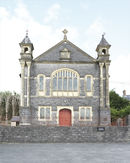West - Capeli
Capeli - Chapels
Contemporary nonconformist chapels in west Wales continue to play an important role within their respective communities. At times, however, these chapels can seem uncanny and disconnected from the everyday world.
Despite a decline in worship over many decades, a significant number of these buildings can still be found in hamlets, villages and towns across the region. Not least, it is recognised that many nonconformist chapels played a key role in the survival of the Welsh language and were important in the continuity of Welsh cultural life.
Today, some chapels continue their religious ritual and funerary activities, whilst others have been converted for non-religious use. Excellent acoustics make chapels ideal as musical performance venues, recording studios and locations for choral practice. Their uncomplicated architecture also makes them popular for commercial use and conversion into private dwellings.
Contemporary nonconformist chapels in west Wales continue to play an important role within their respective communities. At times, however, these chapels can seem uncanny and disconnected from the everyday world.
Despite a decline in worship over many decades, a significant number of these buildings can still be found in hamlets, villages and towns across the region. Not least, it is recognised that many nonconformist chapels played a key role in the survival of the Welsh language and were important in the continuity of Welsh cultural life.
Today, some chapels continue their religious ritual and funerary activities, whilst others have been converted for non-religious use. Excellent acoustics make chapels ideal as musical performance venues, recording studios and locations for choral practice. Their uncomplicated architecture also makes them popular for commercial use and conversion into private dwellings.
















